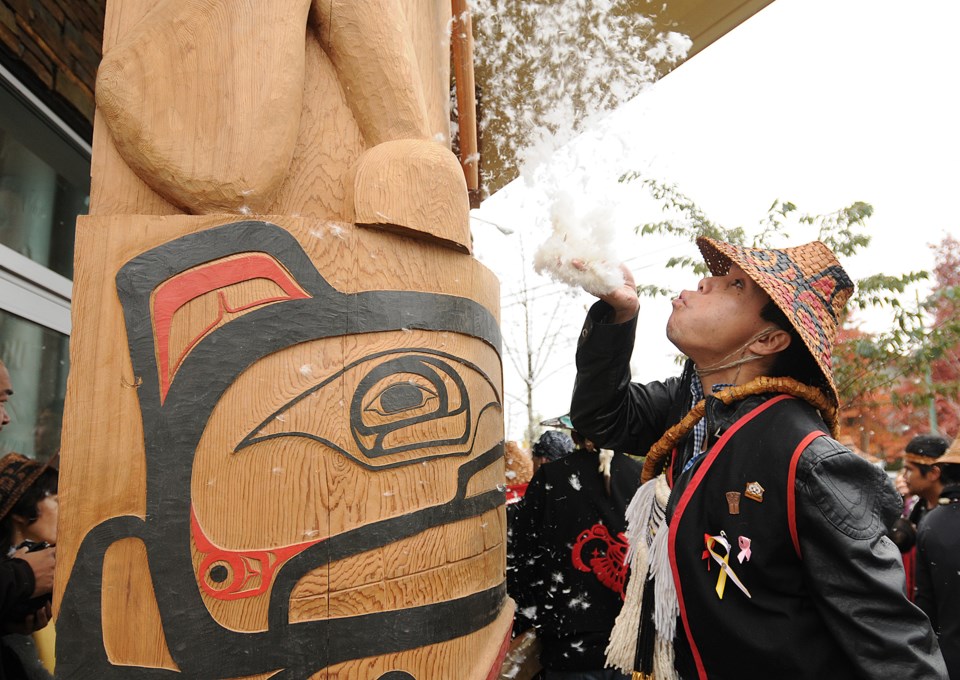The opening of an aboriginal housing development built for foster children and their families along the Grandview Highway corridor took on a special meaning for Patrick Stewart last Friday.
Not only did Stewart design the David Pranteau Aboriginal Children’s Village at Grandview Highway and Nanaimo Street, the architect is a former foster child.
“I went to eight different schools in 12 years,” Stewart told the Courier after an elaborate ceremony that included aboriginal dancers and the unveiling of totems. “I didn’t have that stability of one spot. So here, for a child to be allocated a unit and have the opportunity to stay here — that’s awesome.”
Aboriginal foster children are placed in units with foster parents. But if the parents and children don’t prove to be a good match, it’s the parents who have to move on — not the children, as Stewart did when he was a child.
“The whole foster system needs an overhaul and this is a good start,” he said.
The 24-unit building is set up so a foster child could conceivably remain a resident for many years. Some of the units are so-called transition apartments designated for children once they become adults.
Counselling and support for families and children is available at the building, along with training for foster parents and respite workers. An aboriginal art mentorship program, which has welcomed celebrated artist Robert Davidson, is on site.
While Stewart is proud of the new building, he said the public should not lose sight of the fact that thousands of aboriginal people are on waiting lists for suitable and affordable housing in Vancouver and the Lower Mainland.
Lu’ma Native Housing Society, which owns and manages the building, has a waiting list of 4,500 people wanting housing. Other First Nations societies such as Vancouver Native Housing Society also have long waiting lists, Stewart said.
The City of Vancouver’s release last month of its March 2013 homeless count also showed aboriginal people comprised 30 per cent of the city’s homeless population, although Stewart believes the number is higher. He suggested some of those homeless were likely foster children at one point in their lives.
“There’s such a high correlation between being a foster child and homelessness and something like this [building] will hopefully get people another option,” he said.
But, he acknowledged, getting more housing complexes built in Vancouver is an expensive venture, noting the new building cost $17 million and took seven years of wrangling with all three levels of government to get it built.
Lu’ma contributed $10.6 million, with the provincial government kicking in $5.2 million and the federal government adding $710,000. The City of Vancouver provided $240,000 in addition to levy reductions of more than $214,000.
Marjorie White, the vice president of Lu’ma Native Housing Society, said the lack of funding committed to more affordable housing makes it difficult to meet the needs of people without decent homes or living on the street. Lu’ma already has 380 apartments spread over 15 buildings.
“We do have a long ways to go,” White said. “As we provide housing for individuals, there’s always new people moving in to the city. It just adds to our waiting list.”
The building was named after Dave Pranteau, who was described by White and others as a tireless leader in the aboriginal community who pushed for more housing and improving social and economic conditions for aboriginal people. He died last year.
“Dave was well known to many of us here in Vancouver and elsewhere in British Columbia for his leadership, teachings and compassion,” White said. “He has been by our side and we believe he still is in helping our cause to advocate for safe, culturally appropriate and affordable housing for aboriginal peoples.”



